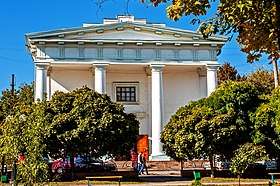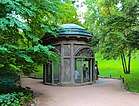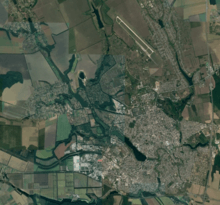Uman
Uman (Ukrainian: Умань, IPA: [ˈumɐnʲ]; Polish: Humań) is a city located in Cherkasy Oblast (province) in central Ukraine, to the east of Vinnytsia. Located in the historical region of the eastern Podolia, the city rests on the banks of the Umanka River at around 48°45′N 30°13′E. Uman serves as the administrative center of Uman Raion (district), but is designated as a city of oblast significance and does not belong to the raion. Population: 85,473 (2017 est.)[2]
Uman Умань | |
|---|---|
  _P1260332.jpg)  | |
 Flag  Coat of arms | |
 Uman Location of Uman  Uman Uman (Ukraine) | |
| Coordinates: 48°45′0″N 30°13′0″E | |
| Country | |
| Oblast | |
| Raion | City of Uman |
| Founded | 1616 |
| Magdeburg rights | 1760 |
| Government | |
| • Mayor | Oleksandr Tsebriy |
| Area | |
| • Total | 41 km2 (16 sq mi) |
| Elevation | 166 m (545 ft) |
| Population (2019) | |
| • Total | 82 950[1] |
| Postal code | 20300 |
| Area code(s) | +380 4744 |
Among Ukrainians, Uman is known for its depiction of the Haidamak rebellions in Taras Shevchenko's longest of poems, Haidamaky ("The Haidamaks", 1843).[3] The city is also a pilgrimage site for Breslov Hasidic Jews and a major center of gardening research containing the dendrological park Sofiyivka and the University of Gardening.
Uman (Humań) was a privately owned city of Poland and the Polish-Lithuanian Commonwealth.
History
Uman was first mentioned in historical documents in 1616, when it was under Polish rule.[4] It was part of the Bracław Voivodeship of the Lesser Poland Province of the Polish Crown. Its role at this time was as a defensive fort to withstand Tatar raids, containing a prominent Cossack regiment that was stationed within the town. In 1648 it was taken from the Poles by Ivan Hanzha, colonel to Cossack leader Bohdan Khmelnytsky, and Uman was converted to the administrative center of cossack regiment for the region.[4] Poland retook Uman in 1667, after which the town was deserted by many of its residents who fled eastward to Left-bank Ukraine.[4] From 1670–1674, Uman was a residence to the Hetman of right-bank Ukraine.. It was part of Ottoman Empire between 1672 and 1699.
Under the ownership of the Potocki family of Polish nobles (1726–1832) Uman grew in economic and cultural importance. A Basilian monastery and school were established in this time.[4]
The Uman region was site of haidamaky uprisings in 1734, 1750, and 1768.[4] Notably during the latter, Cossack rebels Maksym Zalizniak and Ivan Gonta captured Uman during the Koliyivshchyna uprising against Polish rule. During this revolt, a massacre took place against Jews, Poles and Ukrainian Uniates.[4] On the very first day large numbers of Ukrainians deserted the ranks of Polish forces and joined the rebels when the city was surrounded. Thousands from the surrounding areas fled to the Cossack garrison in Uman for protection. The military commander of Uman, Mladanovich, betrayed the city's Jews and allowed the pursuing Cossacks in, in exchange for clemency towards the Polish population. In the span of three days an estimated 20,000 Poles and Jews were slain with extreme cruelty, according to numerous Polish sources, with one source[5] giving an estimate of 2,000 casualties. Uman's modern coat-of-arms commemorates the event depicting a "Koliy" rebel armed with a spear.
With the 1793 Second Partition of Poland, Uman became part of the Russian Empire and a number of aristocratic residences were built there. In 1795 Uman became a povit/uezd center in Voznesensk Governorate, and in 1797, in Kiev Governorate.[4]
Into the 20th century, Uman was linked by rail to Kiev and Odessa, leading to rapid development of its industrial sector.[4] Its population grew from 10,100 in 1860 to 29,900 in 1900 and over 50,000 in 1914.[4] According to the Russian census of 1897, Uman with a population of 31,016 was the second largest city of Podolia after Kamianets-Podilskyi.
In 1941, the Battle of Uman took place in the vicinity of the town, where the German army encircled Soviet positions. Adolf Hitler and Benito Mussolini visited Uman in 1941.

Uman was occupied by German forces from August 1, 1941 to March 10, 1944.
In January 1989 the population was 90,596 people.[6][7]
Today the city has optical and farm-machinery plants, a cannery, a brewery, a vitamin factory, a sewing factory, a footwear factory, and other industrial enterprises. Its highest educational institutions are the Uman National University of Horticulture and the Uman State Pedagogical University. The main architectural monuments are the catacombs of the old fortress, the Basilian monastery (1764), the city hall (1780–2), the Dormition Roman Catholic church in the Classicist style (1826), and 19th-century trading stalls.[4]

Uman's landmark is a famous park complex, Sofiyivka (Софiївка; Polish: Zofiówka), founded in 1796 by Count Stanisław Szczęsny Potocki, a Polish noble, who named it for his wife Sofia. The park features a number of waterfalls and narrow, arching stone bridges crossing the streams and scenic ravines.
Jewish community
A large Jewish community lived in Uman in the 18th and 19th centuries. During the Second World War, in 1941, the Battle of Uman took place in the vicinity of the town, where the German army encircled Soviet positions. The Germans deported the entire Jewish community, murdering some 17,000 Jews,[8] and completely destroyed the Jewish cemetery, burial place of the victims of the 1768 uprising as well as Rebbe Nachman of Breslov. (After the war, a Breslov Hasid managed to locate the Rebbe's grave and preserved it when the Soviets turned the entire area into a housing project.[8])
Since the 1990s there has been a small, but growing, Jewish population in Uman, concentrated around Rebbe Nachman of Breslov tomb in Pushkina street. The local Jews are mostly involved in pilgrimage of Jewish tourists that arrive to the town. In 2018 the community saw large growth with about 10-20 families coming from Israel, accompanied by a small movement of young American couples. Newcomers to the city are concentrating around Skhidna St, with some toward Nova Uman area. In conjunction with this growth in the community, a new school of Yiddish was established. If current trends continue, there will continue to be improvement of the Jewish community in Uman.
Pilgrimage to Rebbe Nachman's grave
Every Rosh Hashana, there is a major pilgrimage by tens of thousands of Hasidim and others from around the world to the burial site of Rebbe Nachman of Breslov, located on the former site of the Jewish cemetery in a rebuilt synagogue.[9] Rebbe Nachman Me'Uman spent the last five months of his life in Uman,[10] and specifically requested to be buried there. As believed by the Breslov Hassidim, before his death he solemnly promised to intercede on behalf of anyone who would come to pray on his grave on Rosh Hashana, "be he the worst of sinners"; thus, a pilgrimage to this grave provides the best chance of getting unscathed through the stern judgement which, according to Jewish faith, Hashem passes on everybody on Yom Kippur.[11]
The Rosh Hashana pilgrimage dates back to 1811, when the Rebbe's foremost disciple, Nathan of Breslov, organized the first such pilgrimage on the Rosh Hashana after the Rebbe's death. The annual pilgrimage attracted hundreds of Hasidim from Ukraine, Belarus, Lithuania and Poland throughout the 19th and early 20th centuries, until the Bolshevik Revolution of 1917 sealed the border between Russia and Poland. A handful of Soviet Hasidim continued to make the pilgrimage clandestinely; some were discovered by the KGB and exiled to Siberia, where they died. The pilgrimage ceased during World War II and resumed on a drastically smaller scale in 1948. From the 1960s until the fall of Communism in 1989, several hundred American and Israeli Hasidim made their way to Uman, both legally and illegally, to pray at the grave of Rebbe Nachman. In 1988, the Soviets allowed 250 men to visit the Rebbe's grave for Rosh Hashana; the following year, over 1,000 Hasidim gathered in Uman for Rosh Hashana 1989. In 1990, 2,000 Hasidim attended.[8][12] In 2008, attendance reached 25,000 men and boys.[13] In 2018, over 30,000 Jews made the Rosh Hashanah pilgrimage to Uman.[14]
Today Israeli Hassidim, from many sectors of Israel's Ultra-Orthodox community, including many Mizrahi Jewish rabbis, make the pilgrimage. The event brings together a wide variety of Orthodox society, from Yemenite yeshiva students, to former Israeli prison inmates, and American hippies.[15]
Economy
The annual pilgrimage is regarded as Uman's main economic industry.[16]
Controversy
The pilgrimage has drawn protests from residents due to the large influx of visitors from Israel, and the consequent strain on security and utility.[17] Common complaints from residents relate to the loud noise, singing, rowdiness, widespread drinking, drug use and fighting the pilgrims cause.[18]
Problems have been reported on the flights with pilgrims smoking cannabis and chanting over the airport PA system. One Israeli tourist said of the flights: "All sorts of people fly to Uman... Some of them arrive drunk or on drugs, embarrassing the rest of us. The local (Uman) police doesn't interfere, because the believers who visit bring in a lot of money."[19] An El Al pilot described his flight to Ukraine: "The flight attendants also detected the smell of marijuana on board, together with a large number of passengers drank hard liquor out of personal bottles".[19]
On September 10, 2010, several cases of violence and riots broke out among Hasidic pilgrims after members of the Jewish Evangelical Church arrived from Odessa to preach their faith, leading to 10 Hasidic pilgrims being deported.[20]
Heavy alcoholic drinking and cannabis smoking is prevalent amongst the pilgrims, many of them young men, with some describing it as a party event.[21] Hippies have been seen taking LSD on the pilgrimage.[15] Dancing in the streets to trance music is common and the event has been likened to the burning man festival.[16]
In clashes with locals, cases of Hippies provoking riots occurred. In one instance, pilgrims staying in a residential tower began tossing rocks and bottles from above onto a car, and when at one point a local policeman's hat was knocked off, police with German Shepherds were called to scatter the crowd.[18] On September 13, 2010, ten Hasidic pilgrims were deported back to Israel and banned from Ukraine for five years for disrupting public order and causing bodily harm to citizens. Three more were also under investigation.[20] Later, on September 26, 2010, an Israeli Hasid was stabbed and killed in an altercation that broke out following the vandalism of a car owned by Jews. In pursuing the vandals, who allegedly were retaliating for the recent stabbing and wounding of a local Ukrainian by an Israeli, the man was stabbed and his brother injured.[22][23]
An Israeli police officer sent to the proceedings to monitor security commented, explaining that “people get drunk and act crazy in the streets, go out to pubs and hit on women and harass them. They do all types of things that they would never do in Israel, but they come out here and feel like they can do it.”[24]
On September 25, 2011, a protest rally of about 100 people was held by the nationalist All-Ukrainian Union "Svoboda" to demand 'stricter legal and sanitary controls on pilgrims' and better regulation of Hasidim pilgrims in the interest of risks to local security and health.[25]
On September 8, 2013, three Israeli police officers were deported after getting involved in a bar brawl during the Rosh Hashanah gathering in Uman.[26] In September 2014, a statement issued by the association of Breslov rabbis called on women to cease visiting the gravesite because the presence of women could detract from the sacredness of prayers said by male worshippers. According to the statement the increasing presence of women has created a "huge spiritual interruption."[27] Others defend their position stating that the enormous volume of male worshippers would mitigate the possibility of proper separation of the genders. They say that this separation is necessary to stay focused on the sacred mission of the pilgrimage.
In the 2014 pilgrimage, organizers were fined $15,000 by the city of Uman for illegally operating a "tent city" to house 2,500 pilgrims.[28]
The controversy is the subject of the 2015 documentary film, The Dybbuk. A Tale of Wandering Souls.[29]
Science and education
| Universities |
|
|---|---|
| Institutes and colleges |
|
| Academy of Sciences (research institutes) |
|
Twin towns – sister cities






.svg.png)




Gallery
 Church
Church The Ohel of Rebbe Nachman of Breslov
The Ohel of Rebbe Nachman of Breslov An office building in Uman
An office building in Uman- Late 19th century architecture in Uman
- School building (mid-19th century)
- Hotel Sofiivskyi in Uman
- Uman bus station
.jpg) Soviet apartment blocks
Soviet apartment blocks.jpg) Agrotechnical college
Agrotechnical college.jpg) Police department
Police department.jpg) Sadova Street
Sadova Street
See also
- Sofiyivsky Park – a landscape park near the city
References
- Чисельність населення (за оцінкою) на 1 травня 2019 року // Головне управління статистики у Черкаській області
- "Чисельність наявного населення України (Actual population of Ukraine)" (in Ukrainian). State Statistics Service of Ukraine. Retrieved 26 August 2017.
- Magocsi, A History of Ukraine, 1996, p297
- "Uman". Encyclopedia of Ukraine. Retrieved 26 September 2011.
- Paul Robert Magocsi "A History of Ukraine", Univ. of Washington Press 1996, p.300
- Всесоюзная перепись населения 1989 г. Численность городского населения союзных республик, их территориальных единиц, городских поселений и городских районов по полу
- Умань // Большой энциклопедический словарь (в 2-х тт.). / редколл., гл. ред. А. М. Прохоров. том 2. М., "Советская энциклопедия", 1991. стр.525
- "Uman! Uman! Rosh HaShanah! A guide to Rebbe Nachman's Rosh HaShanah in Uman".
- David M. Gitlitz & Linda Kay Davidson Pilgrimage and the Jews (Westport: CT: Praeger, 2006), 115-117.
- Kaplan, Aryeh (1985). "Until the Mashiach: Rabbi Nachman's biography: an annotated chronology". Jerusalem/New York: Breslov Research Institute. Chapter 24: Uman 5570 (1810).
- "Anyone in the world, be he the worst and most corrupt of sinners, would he come to my grave, give a penny to charity on my behalf and chant the Ten Mizmorim, then would I overturn the very Heavens on his behalf, and from the Most High of Heights would I descend to the Deepest Depths of Hell, to pull him out" (Breslov website (Hebrew) ).
- See the article "A New Phase in Jewish-Ukrainian Relations" by Mitsuharo Akao
- "Hasidic Jews celebrate holiday in Uman" Archived 2010-05-14 at the Wayback Machine Jewish Telegraphic Agency, 2008-10-02. Retrieved 2009-08-01.
- https://www.theyeshivaworld.com/news/israel-news/1586099/30000-israelis-heading-to-uman-for-rosh-hashanah.html
- Rosh Hashana in Uman: A Jewish anarchy By NATAN ODENHEIMER, 10/02/2016, Jerusalem Post
- How Do You Say Shofar in Ukrainian? The strange and wonderful Hasidic pilgrimage to Uman, Ukraine., By Menachem Kaiser
- "In Uman Hasidic march against tyranny".
- Hartman, Ben. "Uman: Riot erupts between pilgrims and Ukrainian police - Jewish World - Jerusalem Post". Jpost.com. Retrieved 2015-05-30.
- Watch: Fighting on Uman-bound flight, shenanigans at Kiev airport Itay Blumental|Published: 06.10.16, ynetnews
- Interfax-Ukraine. "Ten Hasidic pilgrims deported from Ukraine". Kyiv Post.
- Rabbi rolling in his grave, Akiva Novick, 14.09.10
- Breslov Hasid murdered in Uman ynetnews.com
- "Yanukovych orders to control investigation into murder of Israeli citizen in Uman". Kyiv Post. Sep 27, 2010.
- Hartman, Ben. "Uman: Riot erupts between pilgrims and Ukrainian police". The Jerusalem Post. Retrieved 10 September 2010.
- Reuters (25 September 2011). "Ukrainian nationalists protest over Jewish pilgrims". Kyiv Post. Retrieved 25 September 2011.
- Reback, Gedalyah (2013-09-08). "Israeli cops sent home after Uman bar fight". Timesofisrael.com. Retrieved 2015-05-30.
- "Women asked not to visit Breslov rabbi's grave - Israel Jewish Scene, Ynetnews". Ynetnews.com. Retrieved 2015-05-30.
- Reback, Gedalyah (2014-09-25). "Uman fines Jewish community for pilgrims' unlicensed tent city". Timesofisrael.com. Retrieved 2015-05-30.
- ""A TALE OF WANDERING SOULS" - INTERVIEW WITH KRZYSZTOF KOPCZYŃSKI". Polish Docs. 29 May 2015. Retrieved 15 June 2015.
- "Міжнародні зв'язки". uman-rada.gov.ua (in Ukrainian). Uman. Retrieved 2020-03-31.
Bibliography
- (in Ukrainian) (1972) Історіа міст і сіл Української CCP - Черкаська область (History of Towns and Villages of the Ukrainian SSR - Cherkasy Oblast), Kyiv.
External links
| Wikimedia Commons has media related to Uman. |
| Wikivoyage has a travel guide for Uman. |
(in English) Uman in the Encyclopedia of Ukraine
- (in Ukrainian) Uman informational portal
- (in Ukrainian) Evening Uman. Uman informational portal and newspaper
- (in Ukrainian) Uman photos. Uman biggest photos collection portal
- (in Ukrainian) Uman videos. YouTube channel of videos of Uman
- (in English) All about Uman
- History of Jewish Community in Uman
- Uman News and informational portal